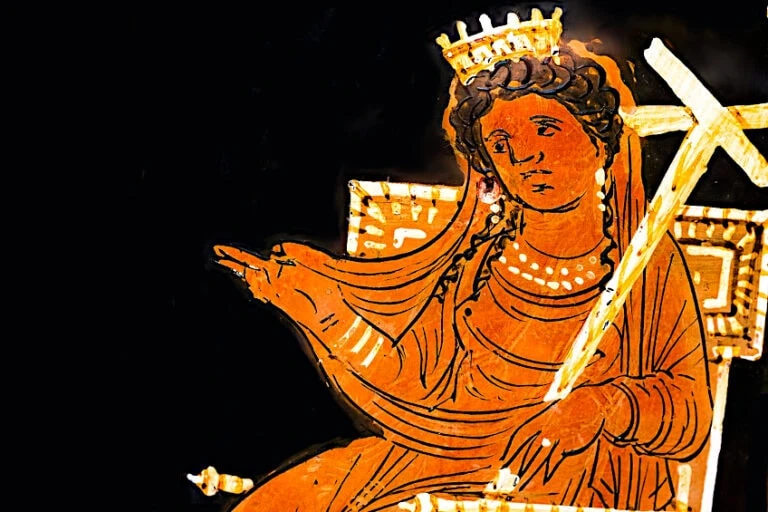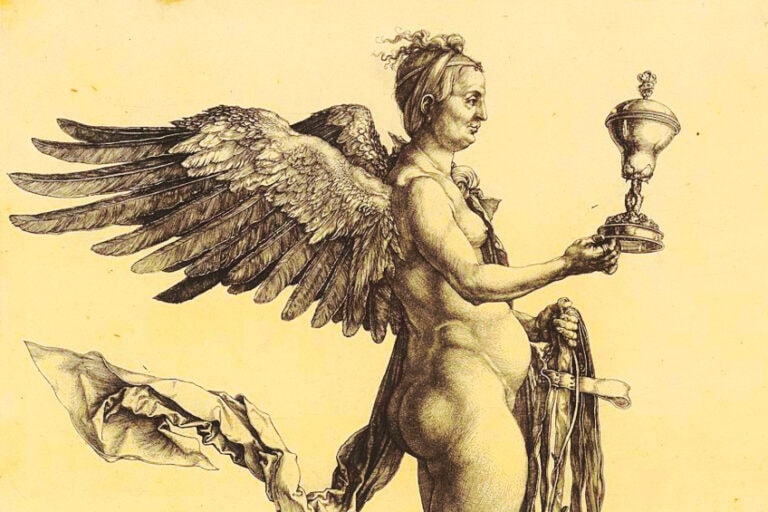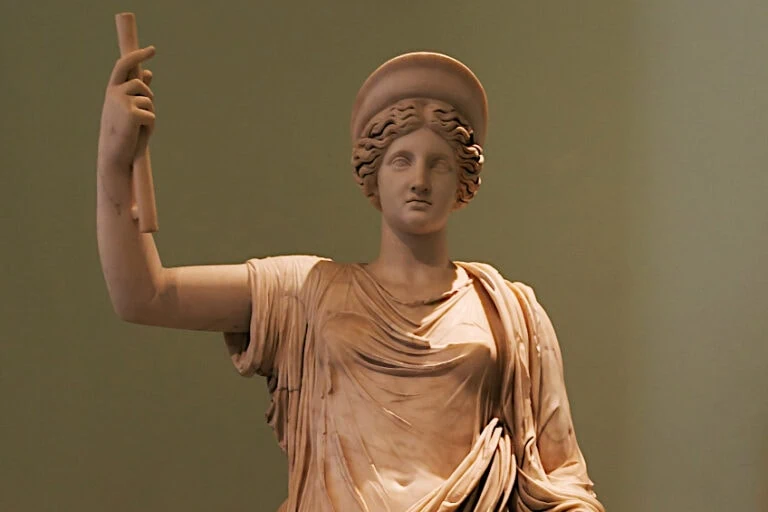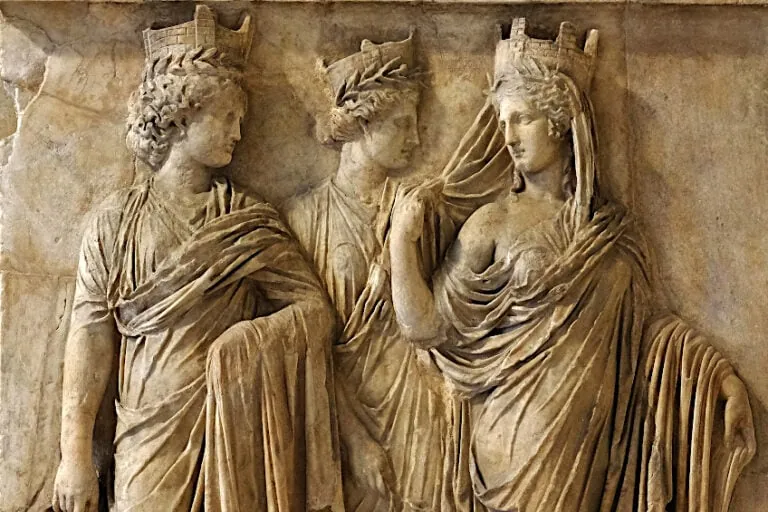Greek Goddess Athena – Explore Athena in Greek Mythology
What is Athena the goddess of and what is Athena passionate about? When it comes to Athena, Greek mythology regards her as the ancient goddess of wisdom and war. The Greek goddess Athena was also responsible for certain crafts such as pottery and weaving, as well as for protecting towns against attacks from outsiders. Let us find out the significance of Athena’s mythology, in addition to other relevant bits of information, such as Athena’s Roman name, her symbols, her domain of influence, and so much more!
Contents
The Greek Goddess Athena’s Mythology
| Name | Athena, Pallas, and Athene |
| Gender | Female |
| Personality | Confident, clever, and a great warrior |
| Parents | Zeus and Metis |
| Spouse | Hephaestus |
| Siblings | The Olympians |
| Domain | Wisdom, crafts, war, and protection of towns |
| Symbols | Aegis, Gorgoneion, snakes, olive trees, and owls |
According to legend, the Greek goddess Athena was the leader of the Athenai. This was a community of women that revered and followed her. Some contend that the city of Athens was named after her by the inhabitants, while others say that she was named after the city had been established. Many believe that she obtained her name because she lived in Athens and ruled from there. Plato cited her name in his writings and stated that people followed her because of her great knowledge and wisdom as early as 407 BCE. He additionally asserted that her name was derived from the Greek Athenoa, which could refer to the earth, moon, or air.
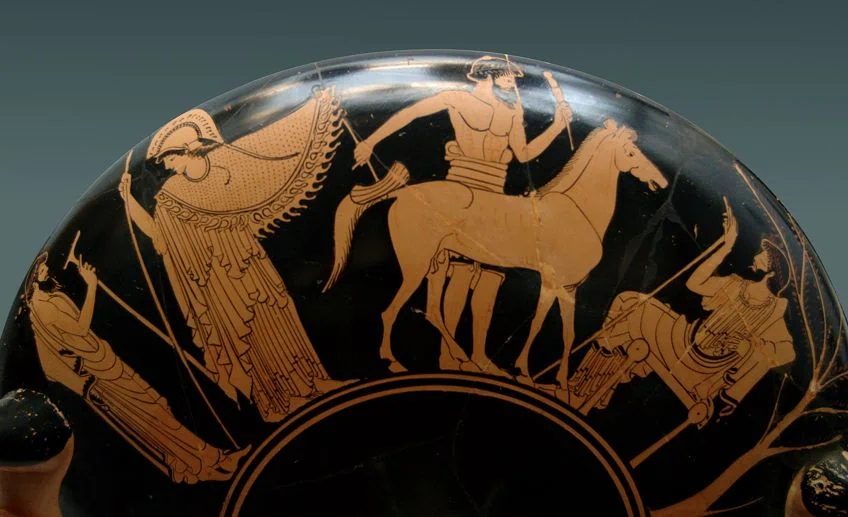 Athena wearing aegis visiting (as goddess of art) the workshop of a sculptor working on a marble horse (ca. 480 BC); Foundry Painter, Public domain, via Wikimedia Commons
Athena wearing aegis visiting (as goddess of art) the workshop of a sculptor working on a marble horse (ca. 480 BC); Foundry Painter, Public domain, via Wikimedia Commons
She was revered as a war goddess, guiding warriors in preparation for battle and providing them with the required equipment and supplies. The Greek goddess Athena was unlike other divinities from Greek mythology who believed that everything was worth battling over. She felt that combat should only be carried out as a last option and for an honorable or good cause. Scholars later referred to Athena as Parthenos, a Greek word meaning virgin. Not only did the Greek goddess Athena never marry, but she also never had a lover. Many people today assume that the Parthenon got its name from the phrase used to characterize her virginity. The city’s residents picked this name in recognition of her sexual modesty. Her virginity, they felt, helped pave the way for other women to follow.
The Greek Goddess Athena’s Background and Family
Despite being associated with the city of Athens, Athena had worshipers in other towns too. These Panhellenic cults were made up of women who practiced the ancient Greek rites. The majority of those who followed her were younger women who appreciated socializing with people in their hometowns as well as in other parts of the country. While some attended these gatherings in the hopes of finding a suitable person for marriage and the right to citizenship, others just wanted to meet new people. Her various cults built many shrines in her honor across ancient Greece. Athena’s Roman name is Minerva.
Before we delve any deeper into her worship, though, let’s find out more about Athena’s mythology relating to her family and background.
The Birth of Athena
When it comes to the birth of Athena, Greek mythology states that she was Zeus’s daughter, conceived without any mother and born full-grown from his brow. Another version of this birth story states that Zeus devoured the goddess of counsel, Metis, when she was carrying Athena, and that the Greek goddess Athena emerged through Zeus’ forehead when she was fully grown. In the traditional Olympian pantheon, Athena was Zeus’ favorite child and thus wielded enormous power. There are many different versions of her birth story. The first reference is when Ares accused Zeus of favoring Athena since he gave birth to her.
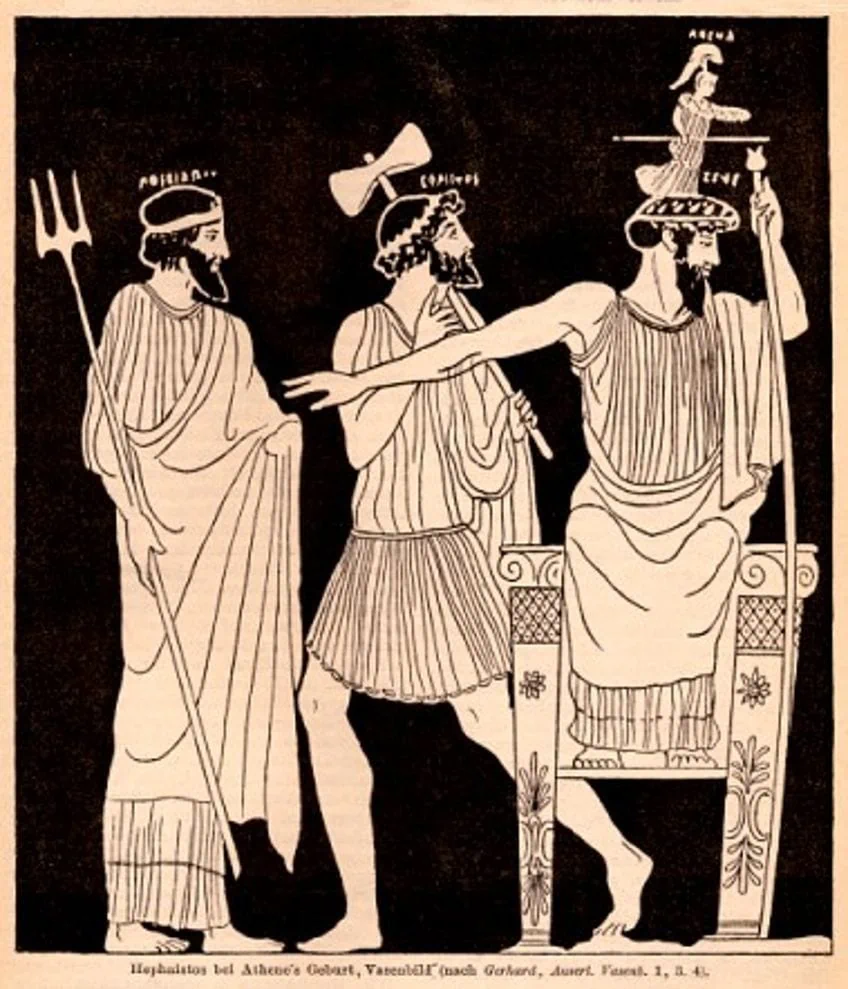 Birth of Athena from the head of Zeus, from a vase painting (n.d); http://www.minervaclassics.com/loom1.htm, Public domain, via Wikimedia Commons
Birth of Athena from the head of Zeus, from a vase painting (n.d); http://www.minervaclassics.com/loom1.htm, Public domain, via Wikimedia Commons
She was regarded as mostly being urban and refined, the polar opposite of the goddess of the outdoors, Artemis. Zeus had six additional wives after consuming Metis, until marrying his current wife, Hera. Zeus then suffered an intense headache. He was in so much pain that he ordered that his skull be cleaved open with the double-headed Minoan ax known as the labrys. At this moment, Athena, fully grown, sprang from Zeus’s head. The gods were stunned at Athena’s arrival, and even the sun god, Helios, came to a halt in the sky. She screamed out, and Mother Earth and the Sky trembled before her. Hera was so enraged at Zeus for bearing a child on his own that she subsequently conceived and gave birth to Hephaestus on her own in revenge.
Athena’s Role in Greek Mythology
As a goddess of wisdom and war, Athena empowered and served Greek heroes; her assistance was associated with military success. Zeus clearly assigned the realm of war to Ares and Athena in the Iliad. Athena’s ethical and military dominance over Ares stemmed in part from her representation of the civilized and intellectual aspect of combat, as well as the values of righteousness and competence, whereas Ares embodied pure blood lust. Her dominance stemmed in part from the far greater diversity and significance of her responsibilities.
She was also given a more significant position by patriotic classical writers such as Homer because Ares was often regarded as a foreign god. Athena was the heavenly embodiment of the heroic ideal: she embodied close conflict, triumph, and glory.
As the protector of rulers, Athena was regarded as the goddess of wise counsel, cautious restraint, pragmatic insight, and combat. Pseudo-Apollodorus claimed a founding myth in which Athena was in competition with Poseidon for Athens’ patronage. They decided that each would offer the Athenians one present, with Cecrops, the ruler of Athens, deciding which was superior. Poseidon hit the earth with his trident, causing a saltwater spring to sprout up, providing the Athenians with water, however, the water was salty and unsuitable for drinking. The first cultivated olive tree was gifted by Athena. Cecrops embraced the gift and made Athena the patron deity of the city-state. The olive tree provided timber, oil, and nourishment, and it came to represent Athenian economic success. Poseidon was so enraged by Athena’s victory that he dispatched one of his sons, Halirrhothius, to chop down the tree. But when he flung his ax, he missed the tree and it slammed into him, killing him.
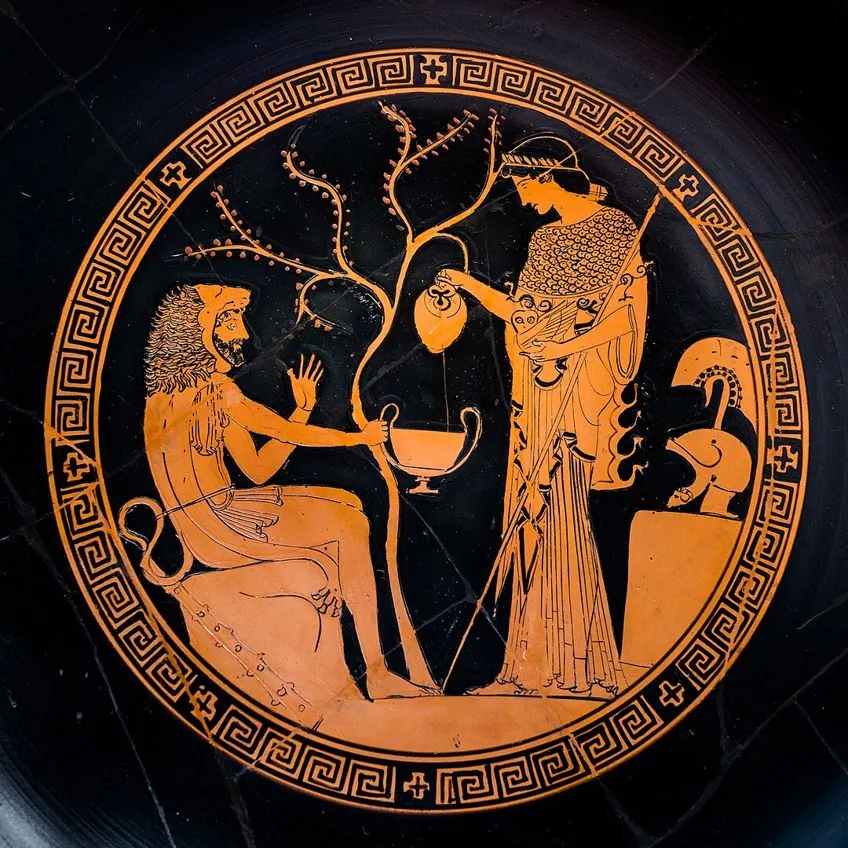 Herakles sitting on a block (resting in Olympus from his labors), holding kantharos, served with wine by Athena (ca. 480-470 BC); ArchaiOptix, CC BY-SA 4.0, via Wikimedia Commons
Herakles sitting on a block (resting in Olympus from his labors), holding kantharos, served with wine by Athena (ca. 480-470 BC); ArchaiOptix, CC BY-SA 4.0, via Wikimedia Commons
Role As the Patron of Heroes
There are many stories that relate to Athena’s role as a patron to various Greek heroes. For example, Athena counseled and assisted Argos, the creator of the Argo, the vessel on which the hero Jason and his party of Argonauts sailed. Athena often also appears in ancient Greek art assisting the hero Heracles. She makes an appearance in four of the 12 metopes representing Heracles’ 12 Labors on the Temple of Zeus at Olympia, particularly the first, in which she silently watches him slaughter the Nemean lion, and the 10th, in which she appears actively assisting him in holding up the sky.
She is portrayed as both his severe ally as well as the kind acknowledger of his accomplishments. Athena drives Heracles to Mount Olympus in her chariot and presents him to Zeus for his deification in artistic portrayals of Heracles’ apotheosis.
In Orestes, Athena saves Orestes from the Erinyes’ fury and presides over his trial for the death of Clytemnestra. When half the jury chooses to release and the other half votes to condemn, Athena casts the final vote to free Orestes and states that the defendant will always be acquitted if the jury is deadlocked from that point onward. Odysseus’ cunning and crafty personality swiftly earns Athena’s favor in The Odyssey. However, throughout the first portion of the poem, she is mostly relegated to assisting him from afar, mostly by putting thoughts in his head during his voyage home from Troy. Her guidance solidifies her reputation as the “protectress of heroes”, thanks to her instruction and motherly prying.
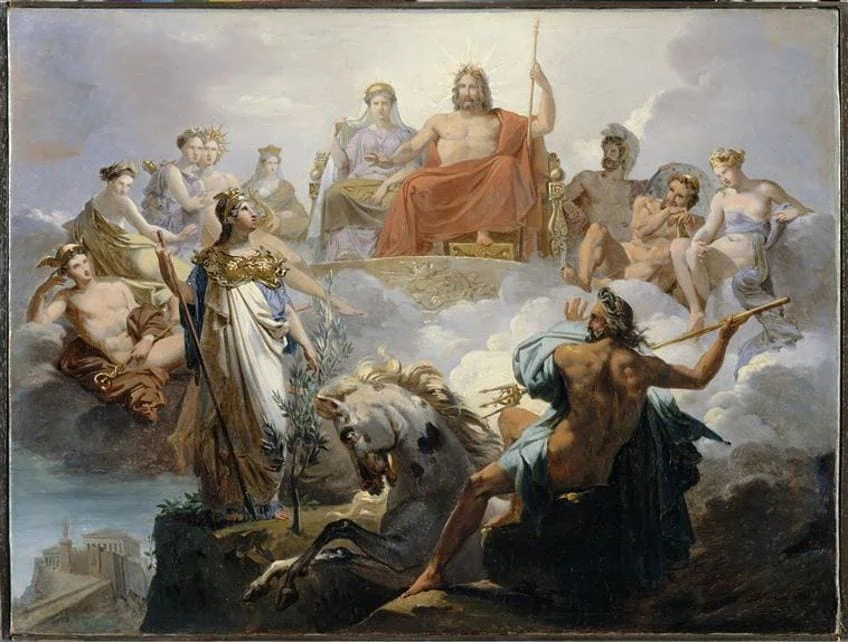 The dispute between Minerva and Neptune over Athens (1882) by Merry-Joseph Blondel; Merry-Joseph BlondelPiouchat, CC BY-SA 4.0, via Wikimedia Commons
The dispute between Minerva and Neptune over Athens (1882) by Merry-Joseph Blondel; Merry-Joseph BlondelPiouchat, CC BY-SA 4.0, via Wikimedia Commons
Athena does not appear personally to give more practical aid until he washes ashore on the coast of the Phaeacians’ island, where Nausicaa is washing her clothes. She arrives in Nausicaa’s dreams to assure Odysseus’s rescue and serves a role in his subsequent passage to Ithaca. Athena appears to Odysseus dressed as a herdsman when he arrives, she first lies, telling him that his wife has remarried and that he is thought to be dead, but he lies back to her, using cunning prevarications in order to defend himself. Athena eventually revealed herself and told him all he needed to know to reclaim his country, impressed by his dedication and shrewdness. Athena then disguised him as an old peasant so that those who were interested and his own wife were unable to recognize him, and she helped him in defeating the suitors.
The Personality of the Greek Goddess Athena
Athena was associated mostly with knowledge, wisdom, and intellectual endeavors. She was portrayed as a smart and perceptive divinity, symbolizing strategic thought and practical advice. The Greek goddess Athena was reputed to provide both heroes and mortals with counsel and inspiration. Athena was revered as a patroness of justice, impartiality, and the rule of law. She embraced the ideals of justice and was regarded as a protector of truth and fairness. Athena’s role in advancing justice is illustrated by her participation in Orestes’ trial when she ruled in his favor. Her worship was fundamental to Athens’ civic life because she personified the principles of a civilized society. Athena was regularly depicted as a virgin goddess, emphasizing her self-sufficiency and independence.
She was recognized for her unflinching dedication to her chosen endeavors and for being able to withstand the allure of romantic interest.
Athena’s Symbolism in Mythology and Art
Early Christian authors vilified the Greek goddess Athena as a symbol of all that was repulsive about paganism, calling her “immodest and sinful”. However, during the Middle Ages, many of Athena’s attributes were ascribed to the Virgin Mary, who often wore the Gorgoneion in 4th-century depictions. There were even some who thought of the Virgin Mary as some sort of warrior, similar to Athena Parthenos; according to one story the Virgin Mary allegedly appeared on the walls of Constantinople during a siege by the Avars, grasping a spear and inspiring the population to join the fight. Athena often served as a Christian allegory and symbol during the Middle Ages, and she often featured on the family crests of several noble households.
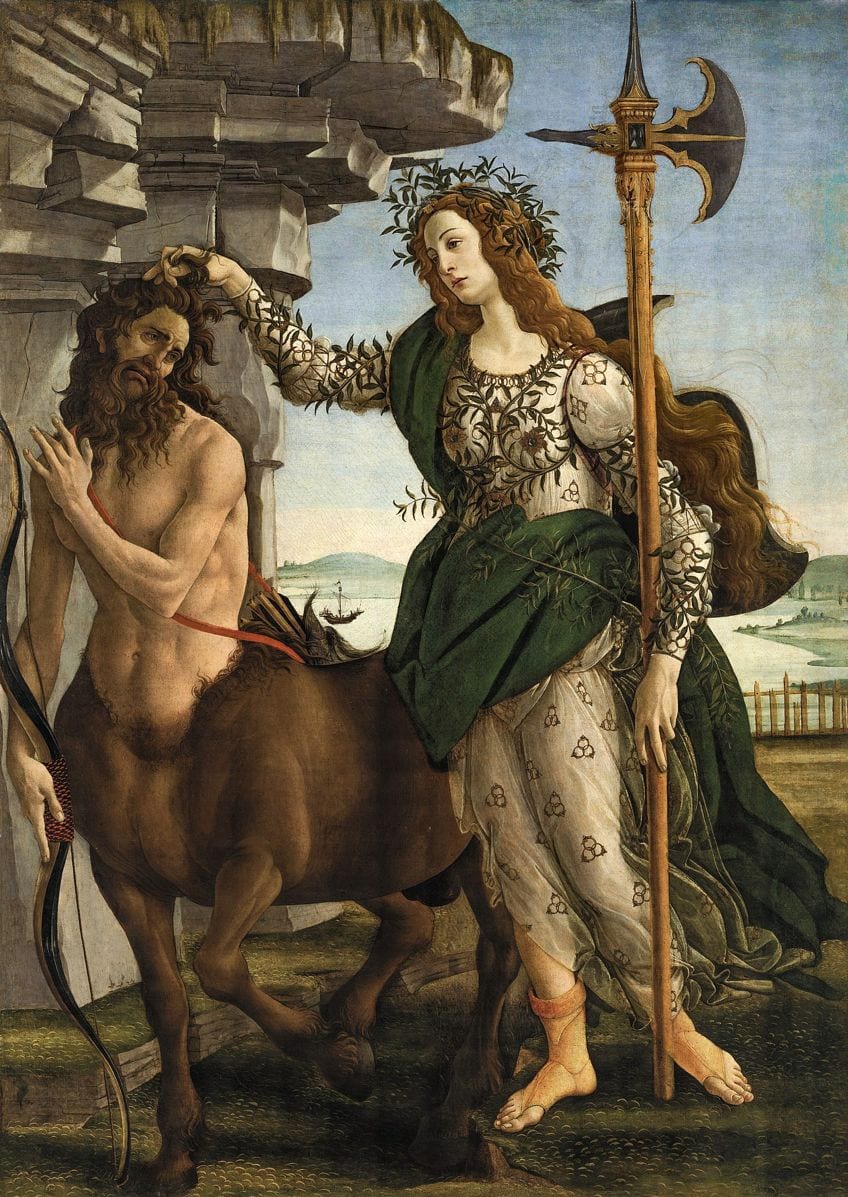 Pallas and the Centaur (the 1480s) by Sandro Botticelli; Sandro Botticelli, CC BY-SA 4.0, via Wikimedia Commons
Pallas and the Centaur (the 1480s) by Sandro Botticelli; Sandro Botticelli, CC BY-SA 4.0, via Wikimedia Commons
Throughout the Renaissance, Athena assumed the role of patron of the arts; allegorical paintings featuring the Greek goddess Athena were popular among Italian Renaissance artists. In Pallas and the Centaur (the 1480s) by Sandro Botticelli, Athena represents chastity, clutching a centaur’s forelock, which represents passion or lust. Athena served as a symbol for female monarchs in the 16th and 17th centuries. Queen Elizabeth I of England was depicted as a “new Athena” by Thomas Blennerhassett. Peter Paul Rubens painted a sequence of works depicting Athena as Marie de’ Medici’s patron and tutor; the last piece in the series depicts Marie de’ Medici with Athena’s symbolism, as the earthly manifestation of the goddess herself. In 1774, Jean-Pierre-Antoine Tassaert, the Flemish sculptor created a marble bust of Catherine II of Russia as Athena.
Sculptures of pagan gods were destroyed all throughout France during the French Revolution, but sculptures of Athena were spared.
Instead, she became the embodiment of liberty and the republic, and a monument of the goddess of wisdom and war stood in the heart of Paris’ Place de la Revolution. Athena’s artistic portrayals increased in the years following the Revolution. In Vienna, a statue of Athena sits right in front of the Austrian Parliament Building, and images of the Greek goddess have influenced other icons of Western liberty, such as Britannia and the Statue of Liberty. A full-scale reproduction of the Parthenon has been on display in Nashville, Tennessee, for over 100 years. The curators installed a gilded 12.5-meter-tall fiberglass and concrete copy of Phidias’ Athena Parthenos in 1990. A depiction of Athena crouching next to a grizzly bear appears on the Great Seal of California.
Modern Interpretations of Athena’s Personality and Symbolism
A little bronze statue of Athena that sat on Sigmund Freud’s desk was one of his most prized items. Sigmund Freud once characterized the Greek goddess Athena as “a woman who is inaccessible and opposes all sexual desires – because she exhibits the Mother’s frightening genitals”. Some feminists regard Athena as an embodiment of feminine strength, while others see her as the archetypal patriarchal sell-out who uses her abilities to advocate for and advance men instead of others of her own sex. In modern Wicca, Athena is revered as a Goddess aspect, and some Wiccans think she may confer the “Owl Gift” (which is the capacity to write and speak well) to her followers.
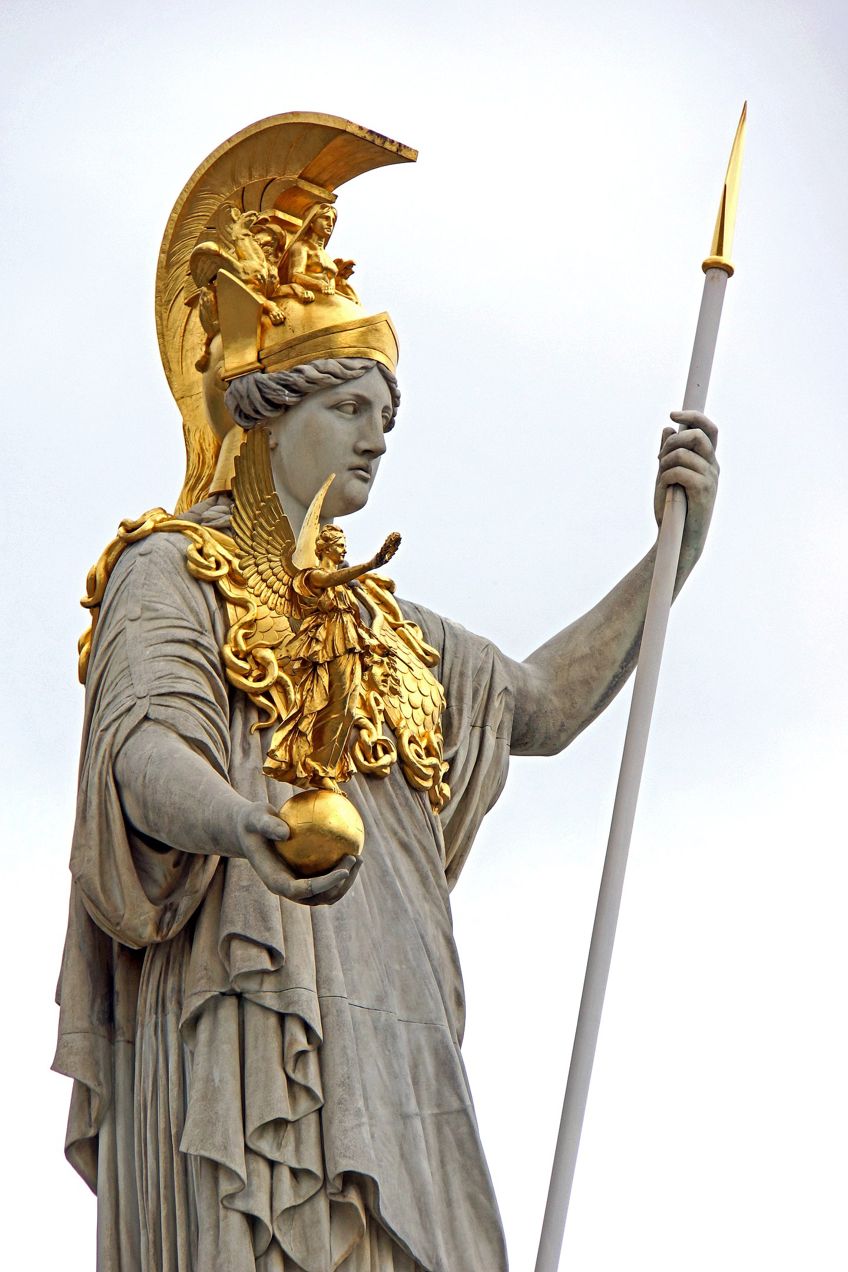 Pallas Athena at The Austrian Parliament building (1902); Dennis Jarvis from Halifax, Canada, CC BY-SA 2.0, via Wikimedia Commons
Pallas Athena at The Austrian Parliament building (1902); Dennis Jarvis from Halifax, Canada, CC BY-SA 2.0, via Wikimedia Commons
Because she is one of the 12 Olympians, the Greek goddess Athena is a key divinity in Hellenismos, a Neopagan religion that attempts to correctly revive and reproduce ancient Greek religion in the modern era. Athena is also regarded as a patron of universities: an effigy of Athena stands in the Great Hall at Bryn Mawr College in Pennsylvania. It is customary for students to send gifts to the deity with a message praying for good luck or to confess to unwittingly violating any of the college’s innumerable other traditions during the examination period. Pallas Athena is the tutelary deity of Phi Delta Theta, an international social fraternity, and her owl is also a fraternal symbol.
The Domain of Influence of the Greek Goddess Athena
Athena has a connection to strategic warfare. On the battlefield, she exemplifies disciplined combat and symbolizes courage and knowledge. The Greek goddess Athena is also the patroness of arts and crafts, as well as practical abilities. She is involved in a variety of arts, including weaving, ceramics, and other crafts. Athena is attributed to inventing the loom and bringing different crafts to humans. Athena is also associated with education and intellectual development.
She motivates and leads others in their quest for knowledge, offering insight and wisdom. Athena is honored as the defender and guardian of Athens and her inhabitants.
Athena’s Greek Mythology
Homer is responsible for many of Athena’s descriptions. He characterized her as an attractive woman with dazzling eyes. This was then modified to imply her eyes were blue-green in later translations. Historians think she became associated with owls because of his descriptions, which indicated she had the same facial characteristics. Others feel this connection stems from the artwork depicting her holding onto an owl in her hand. The owl not only became the Athenian symbol but it was also associated with wisdom. Let’s examine a few of the myths associated with Athena.
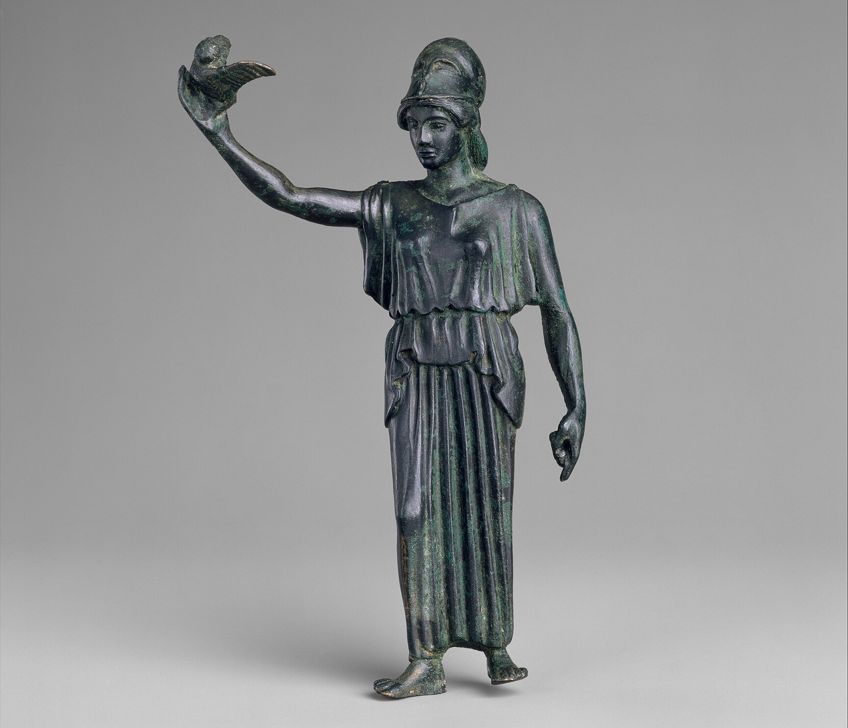 Statuette of Athena flying her owl (c. 460 BC); Metropolitan Museum of Art, CC0, via Wikimedia Commons
Statuette of Athena flying her owl (c. 460 BC); Metropolitan Museum of Art, CC0, via Wikimedia Commons
Athena and Pallas
Pallas is a Greek word with a variety of meanings. It can refer to a young woman or a person who wields a weapon. Pallas became Athena’s sister after Triton adopted her, according to legend. The two had a sparring contest to figure out who was stronger, but Pallas was killed by accident. Athena was so outraged that she started referring to herself using the young woman’s name. According to one version, Pallas is a Gorgon.
Goddess Athena visited his land and engaged in combat with him. When she prevailed, she transformed his flesh into a robe that she wore to demonstrate her triumph to others.
The first legend, according to most historians, is the oldest. There is a monument erected and installed at the Trojan Acropolis depicting Athena as her deceased sister. Locals considered the sculpture to be a talisman with mysterious powers. According to legend, no one could demolish the city for as long as her monument stood. Cassandra wanted to rescue the effigy and refused to abandon it during the Trojan War. Athena was so enraged when Ajax the Lesser dragged her away from the monument that she unleashed a storm that almost killed off the troops.
Athena and Medusa
Medusa was a stunning mortal who enchanted Poseidon, the god of the sea. Poseidon and Medusa had a passionate encounter in Athena’s temple. Enraged by this violation of her holy place, Athena punished Medusa by turning her into a horrible creature with serpents for hair and a stare that turned anybody who stared at her into stone. Everyone was terrified of Medusa, now a Gorgon. Perseus set off on a journey to slaughter Medusa and collect her head as an offering for King Polydectes, who had requested it as a way to get rid of Perseus. He approached her lair with the help of Athena, who gave him a mirrored shield.
 Pallas Athena holding a shield with Medusa’s head in her right hand and a lance in her left hand, from a series of mythological gods and goddesses (1526) by Giovanni Jacopo Caraglio; Giovanni Jacopo Caraglio, CC0, via Wikimedia Commons
Pallas Athena holding a shield with Medusa’s head in her right hand and a lance in her left hand, from a series of mythological gods and goddesses (1526) by Giovanni Jacopo Caraglio; Giovanni Jacopo Caraglio, CC0, via Wikimedia Commons
Perseus decapitated Medusa while she was sleeping, using the shield to prevent direct eye contact. Pegasus and Chrysaor sprang from Medusa’s severed neck. Perseus returned to Athena after completing his mission and offered her Medusa’s head. Perseus’ courage and resourcefulness astonished Athena, who picked up Medusa’s head and put it on her own shield, dubbed the Aegis. It became a representation of protection and was regularly portrayed with Medusa’s scary visage.
Athena and Erichthonius
Hephaestus tried to rape Athena in one myth, but she pulled him away, which led to him ejaculating onto her thigh. Athena swept the sperm away with a clump of wool and flung it onto the ground, impregnating Gaia and resulting in her bearing Erichthonius. Athena then adopted and reared Erichthonius as her son. According to Hyginus’ account of this myth, Hephaestus begged Zeus to let him wed Athena because he was the one who had helped open Zeus’ head, enabling Athena to be born. Zeus approved, and the two were to be married; but, as Hephaestus was about to complete the union, the Greek goddess Athena fled from the wedding bed, forcing him to ejaculate on the floor and impregnate Gaia with Erichthonius.
Athena placed the baby Erichthonius in a little box and committed him to the care of Cecrops’ three daughters: Pandrosos, Herse, and Aglauros of Athens.
She advised them not to open the chest, but she didn’t say why or what was contained inside. The chest was eventually opened by Aglauros possibly along with one of the other sisters. According to several different versions, they either discovered that the infant was a snake, that it was protected by a serpent, that it was protected by two snakes, or that it had a serpent’s body. In Pausanias’ account, the sisters were driven insane by what was inside of the chest and threw themselves from the Acropolis, instantly dying, however, one Attic vase image depicts them getting chased off the cliff by the serpent instead.
Athena and Arachne
Arachne was a gifted mortal weaver who claimed her abilities even surpassed those of the Greek goddess Athena, who was also the deity of acquiring knowledge, crafts, and weaving. Despite the cautions of others, Arachne invited Athena to a weaving competition in order to demonstrate her superiority. Athena then appeared before Arachne dressed as an old lady and told her to show reverence to the gods and withdraw her haughty declaration. Arachne, though, refused to back down and insisted on the competition taking place. Athena and Arachne both started creating tapestries.
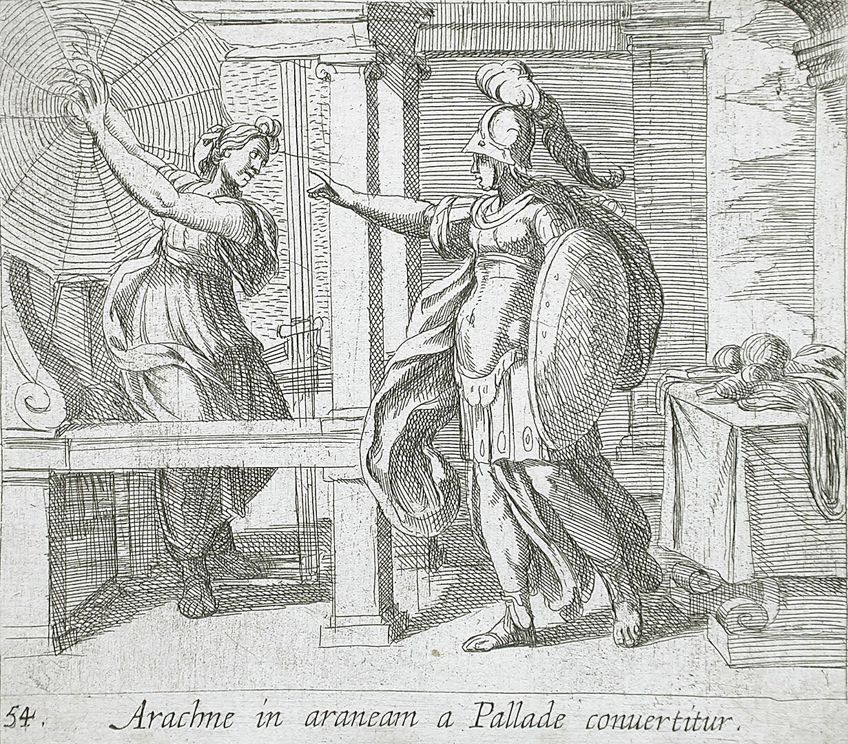 Athena Changing Arachne into a Spider (1606) by Antonio Tempesta; Los Angeles County Museum of Art, Public domain, via Wikimedia Commons
Athena Changing Arachne into a Spider (1606) by Antonio Tempesta; Los Angeles County Museum of Art, Public domain, via Wikimedia Commons
Athena produced a scene displaying the gods’ glory, while Arachne weaved a tapestry portraying the gods’ sins and weaknesses, ridiculing them in the process. Athena viewed both tapestries when they were finished. While she admired Arachne’s brilliance, she was incensed by the mortal’s arrogance and disdain. Athena ripped Arachne’s tapestry apart and turned her into a spider, forcing her to weave for the rest of her life. The fable of Athena and Arachne serves as a warning against arrogance and hubris. It depicts the ramifications of confronting or insulting the gods. It also highlights Athena’s role as a patron of crafts and her contempt for mortals who try to challenge her divine abilities.
Punishment Myths
After Medusa was killed by the hero Perseus, Athena devised the aulos, a type of flute, in imitation of the Gorgons, according to Pindar. The aulos was a gift from Athena to mortals. Later, Melanippides of Melos extended the narrative, stating that Athena saw herself in the mirror while playing the flute and noticed how blowing into it swelled out her cheeks and made her look ridiculous, so she flung it away and cursed whoever picked it up with a terrible death. The flute was eventually found by the satyr Marsyas, who was ultimately assassinated by Apollo for his arrogance.
Later, this version of the tale became regarded as canonical, and the Athenian artist Myron sculpted a set of bronze statues based on it that was put in front of the Parthenon’s western front in approximately 440 BCE.
The tale recounted by Callimachus opens with Athena swimming in a spring on Mount Helicon with the nymph Chariclo, one of her favorite friends. Tiresias, Chariclo’s son, was by chance hunting on the same mountainside and arrived at the spring looking for water. He accidentally saw Athena nude, so she made him blind to make sure he was never again able to see what humanity was not meant to see. Chariclo pleaded on his son’s behalf, pleading with Athena for forgiveness. Tiresias’ eyesight could not be restored, therefore Athena bestowed upon him the power to understand bird language and thereby predict the future.
The Cults and Worship of Athena
Athena was revered as the goddess of the city and the citadel’s protector. Every year, at the close of the month of Thargelion, Athenians celebrated the Feast of the Bath. The celebration lasted five days. During this time, Athena’s priestesses performed the purification rite within the Erechtheion, a temple dedicated to Poseidon and Athena. Her statue was stripped, her clothing was cleaned, and her entire body was purified here. Athena was worshiped as Athena Ergane, the patroness of crafts, during these festivals. She additionally served as a patron of metalworkers and was said to help in the creation of weapons and armor. Her role as the goddess of philosophy became an important aspect of Athena’s devotion in the late 5th century BCE.
 Athena Promachos between Doric columns Panathenaic prize-amphora (530-520 BC); ArchaiOptix, CC BY-SA 4.0, via Wikimedia Commons
Athena Promachos between Doric columns Panathenaic prize-amphora (530-520 BC); ArchaiOptix, CC BY-SA 4.0, via Wikimedia Commons
She was thought to lead warriors into battle as Athena Promachos. In contrast to her brother Ares, who patronized bloodlust, and slaughter, Athena symbolized the strategic side of war. Athena was considered to solely encourage those fighting for a worthy cause and to see battle primarily as a way of resolving turmoil. The Greeks held Athena in considerably greater reverence than Ares for this reason. Athena was especially revered in this position at the Pamboeotia festivals, which included demonstrations of military and athletic ability.
As the patron of heroes, Athena was said to prefer those who employed wit and knowledge above physical power.
Athena was known as Parthenos, a warrior maiden because she was thought to be an eternal virgin. The term Parthenos refers not only to Athena’s virginity but also to her function as the custodian of sexual modesty and ceremonial mystery regulations. The Athenians assigned the goddess significance based on this purity of virginity, which they preserved as a rudiment of feminine conduct. Her virginal epithet is a result of her bond with her father Zeus and has been an important part of her persona throughout the centuries.
This position is expressed in various Athena legends. When Christians took the goddess’s statue from the Parthenon, an exquisite woman came in a vision to Proclus, an Athena follower, and told him that the “Athenian Lady” desired to live with him. Athena is also credited with inventing pebble-based divination. Those stones were known as thriai, which additionally referred to the collective name of an order of clairvoyant nymphs. Her half-brother Apollo, enraged and resentful at the practitioners of a competing profession, protested to Zeus about it, claiming that while many people cast pebbles, only a few were legitimate prophets. Zeus, sympathetic to Apollo’s plight, invalidated pebble divination by making the stones unusable.
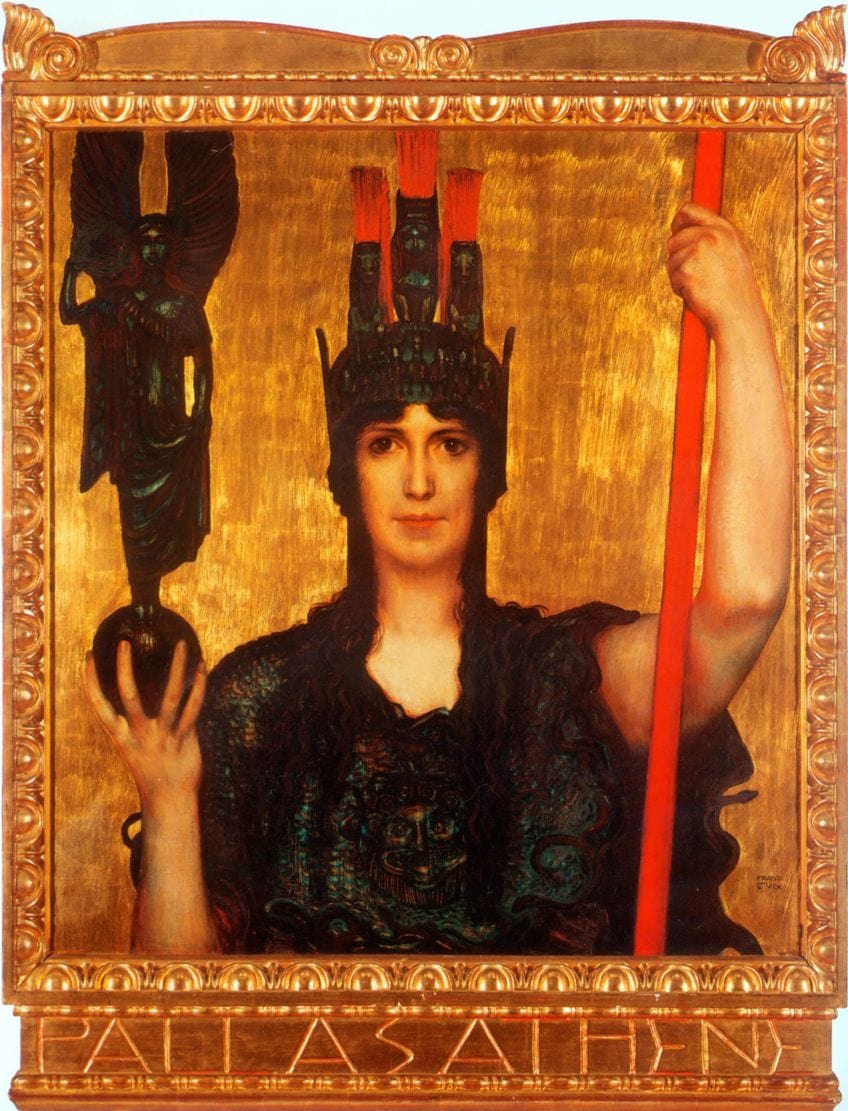 Pallas Athene (1898) by Franz Stuck; Franz Stuck, Public domain, via Wikimedia Commons
Pallas Athene (1898) by Franz Stuck; Franz Stuck, Public domain, via Wikimedia Commons
Regional Cult Worship
Athena was the patron goddess of not only the city of Athens, but also Sparta, Argos, Lindos, Gortyn, and Larisa. The many Athena cults were all extensions of her panhellenic religion and frequently presided over different initiation ceremonies of Grecian youth, such as young men’s entrance into citizenship or young women’s transit into marriage. These cults served as conduits for consistent socialization that extended beyond continental Greece.
Athena was often identified with Aphaea, a native deity of the Greek island of Aegina who also had a connection with Artemis.
She had been combined with the ancient deity Alea and venerated as Athena Alea in Arcadia. Athena Alea shrines might be found in the Laconian cities of Tegea and Mantineia. Tegea’s Athena Alea Temple was an important religious site in ancient Greece. Aleus established the temenos, according to the geographer Pausanias. Athena also had a significant temple on the Spartan Acropolis, where she was known as Poliouchos. This epithet may allude to the fact that the worshiped figure kept there was constructed of bronze, that the temple walls were built of bronze, or that Athena served as the patron of metalworkers. Bells constructed from bronze and terracotta were utilized as a part of Athena’s religion at Sparta. In the 4th century BCE, Priene had an Ionic-style temple dedicated to Athena Polias erected. Pytheos of Priene, the same architect who created the Mausoleum at Halicarnassus, designed it. Alexander the Great consecrated the temple, and a plaque from the temple detailing his dedication is currently housed in the British Museum.
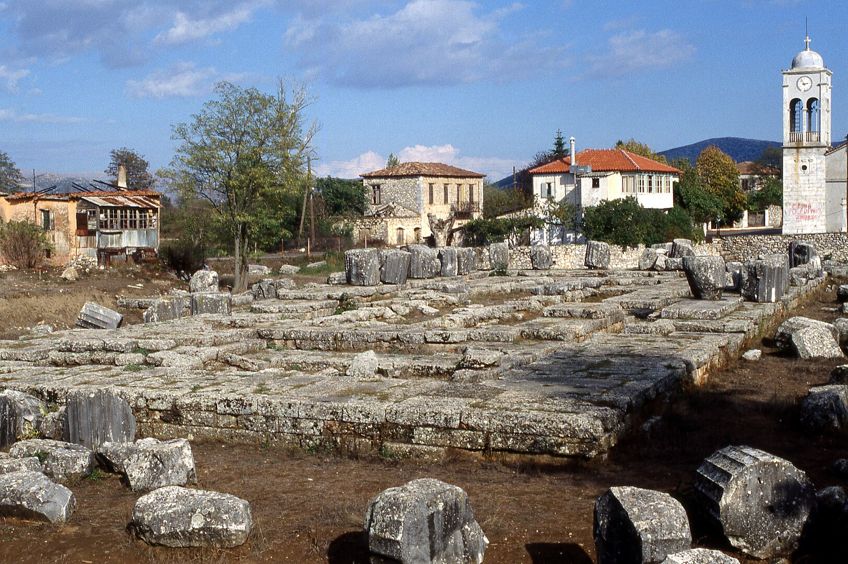 Temple of Athena Alea at Tegea (1990); Mark Landon (photographed in 1990; digitized in 2021), CC BY-SA 4.0, via Wikimedia Commons
Temple of Athena Alea at Tegea (1990); Mark Landon (photographed in 1990; digitized in 2021), CC BY-SA 4.0, via Wikimedia Commons
That wraps up this article on Athena’s Greek mythology. Athena was the goddess of wisdom and war. She was Zeus’ favorite daughter and was possibly the brightest, most daring, and most cunning of the Olympians. She is often portrayed with snakes curled at her feet, and an owl on her shoulder, representing her knowledge. Always with the Greek goddess Athena is Aegis, the shield that caught the image of Medusa’s head, which stares forth from the gleaming metal. She has been especially identified with Athens, the city named after her because the inhabitants of Attica selected her as their patron after she gave them the olive tree, a symbol of peace and prosperity.
Frequently Asked Questions
What Is Athena the Goddess of in Greek Mythology?
She is mostly known for her role as the goddess of wisdom and war. As a divinity who offers direction and advice to both heroes and mortals, Athena is admired for her wisdom and insight. She is involved in many different creative and craft projects, such as weaving, ceramics, and other handmade items. The loom and other crafts were introduced to humans by Athena, who is credited with creating them. As a major figure in Athens’ civic life, Athena exemplifies the qualities and goals of a civilized society.
What Is Athena Passionate About?
Justice, fairness, and the rule of law are values that Athena defends. She is associated with the idea of justice in human affairs and is seen as a champion of truth and morality. Athena is also regarded as a goddess of acquiring knowledge. She imparts information and insight while encouraging and assisting others in their quest for knowledge. Scholars and philosophers are said to draw inspiration from Athena. The Greek goddess exemplifies scholarly ambitions, strategic thought, and common sense.

I am deeply passionate about history and am constantly fascinated by the rich and complex stories of the past. As the editor-in-chief of learning-history.com, I have the opportunity to share this passion with a wide audience through the creation and distribution of engaging and informative content about historical events, persons, and cultures. Whether it’s through writing articles and blog posts or creating videos or podcasts, I strive to bring the past to life in a way that is both accurate and enjoyable. My expertise in history, combined with my strong writing and communication skills, allows me to effectively communicate complex historical concepts and make them accessible and interesting to a wide range of readers. I am truly grateful for the opportunity to share my love of history with others through my work on learning-history.com.


